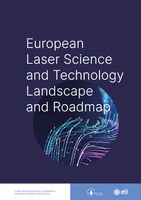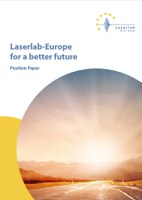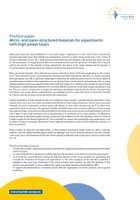Position Papers & Reports
European Laser Science and Technology Landscape and Roadmap
|
|
Laserlab-Europe and the Extreme Light Infrastructure (ELI ERIC) have joined forces to analyse the current laser-based science landscape in Europe. The analysis aims to assess the European laser community to provide a better understanding of the services offered to users by Research Infrastructures (RIs) operating laser sources as well as the user needs and requirements. Published: 2023 Download |
Position Paper 'Laserlab-Europe for a better future'
|
|
In a joint position paper, Laserlab-Europe highlights its integrated, cross-domain and multi-faceted approach to address the societal challenges of the Horizon Europe Missions. Laserlab-Europe, a consortium of leading national laser research infrastructures, provides a unique integrated, cross-domain and multi-faceted approach to the complex scientific and technological questions inherent in today’s global societal challenges. With its extensive set of advanced laser research infrastructures, scientific expertise, innovative research and services, Laserlab-Europe addresses the scientific issues in all three Pillars of Horizon Europe. It promotes new horizons for the European Green Deal, Europe’s Beating Cancer Plan, the UN’s Sustainable Development Goals, and, in particular, the Horizon Europe Missions. Published: 2021 Download |
Position Papers of Laserlab-Europe Expert Groups
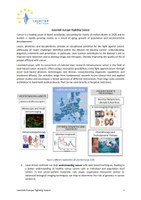 |
Laser science for cancer researchLaserlab Europe provides outstanding laser-based cancer research performed by its members as well as a unique innovation potential for disruptive technologies. These activities showcase the role lasers play from understanding cancer to advanced diagnostics up to treatment modalities - on the level of fundamental or pre-clinical research up to the clinical application. Published: May 2022 Download |
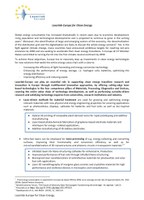 |
Lasers for clean energyThe most important source of energy on Earth is sunlight. Its interaction with matter drives life in a number of important processes, not the least of which, photosynthesis. The interaction of light with matter has been the basis for the development by humans of various devices that aim at exploiting sun light, converting it into electricity via photovoltaics or into chemical energy via photocatalysis. Photovoltaics and photocatalysis are nowadays very intense areas of research with the development and synthesis of new, cheap materials , and the characterization of the fundamental light-induced phenomena within these is essential for their use in applications. Laser light can also be used to process and grow new materials with structures, morphologies, etc., that are optimized for energy conversion purposes. Laserlab-Europe is at the forefront of clean energy research as its members are involved in materials processing, characterization and device fabrication for energy conversion purposes. Several labs have world-unique capabilities for fundamental studies, while others in laser processing of materials. This places Laserlab-Europe in a unique position to lead efforts involving photons for clean energy. Published: June 2022 Download |
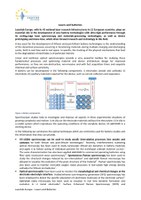 |
Lasers and BatteriesLaserlab-Europe, with its 45 national laser research infrastructures in 22 European countries, plays an essential role in the development of new battery technologies with ultra-high performance through its cutting-edge laser spectroscopy and materials-processing technologies, as well as device prototyping and know-how, which drive forward research and technology in this field. Published: May 2022 Download |
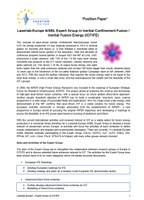 |
Laser-driven ICF/IFEThe recent achievement at the National Ignition Facility (NIF) in the USA of nearly reaching fusion ignition with laser-driven technologies sets a historical milestone in fusion energy research. It confirms inertial fusion as a viable approach for future energy production. Europe has a unique opportunity to empower research in this field and the scientific community is ready to engage on this journey.Screenshot 2022-03-29 at 11.50.00.png The Laserlab-Europe AISBL Expert Group in ICF acts as a forum for discussing potential advances in the field within Europe and intends to develop a broad network of researchers across Europe, to promote and focus the activities of each institution to define mutual collaborations and prepare joint experimental campaigns. Published: June 2022 Download |
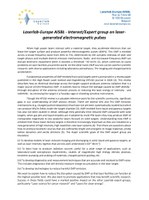 |
Laser-generated electromagnetic pulsesWhen high power lasers interact with a material target, they accelerate electrons that can leave the target surface and produce powerful electromagnetic pulses (EMPs). This EMP is emitted across a broad frequency band from MHz to THz, determined by the complex interplay of laser and target physics and multiple distinct emission mechanisms. Radio- and microwave-frequency EMP can disrupt electronic equipment when it exceeds a threshold ~10 kV/m [1], which continues to cause problems on laser facilities around the world. On the other hand, EMP sources can be used for scientific research, with diverse applications including laboratory astrophysics, THz imaging and charged particle acceleration. Published: April 2022 Download |
|
|
Micro- and nano-structured materials for experiments with high-power lasersHigh-power lasers are used worldwide for a very wide range of applications. To cite a few of them, nanosecond terawatt-scale peak power laser facilities are employed for research on clean energy production in the context of Inertial Confinement Fusion (ICF), while picosecond and femtosecond petawatt-scale peak power lasers are used for the acceleration of charged particle (electrons and protons/ions) and the generation of bright XUV, X-ray and gamma-ray sources. In the majority of these experiments, the choice of the target material and its structure is crucial to achieve the desired interaction regime or enhance the source performance. The present expert group comprises members of Laserlab-Europe AISBL with strong common research interests and expertise in the experimental study of the features of the interaction of micro- and nano-structured materials with high power lasers. Their common interest in these research topics over multiple experimental grounds is driving our efforts towards the organization of joint activities and collaborations. Published: September 2023 Download |


